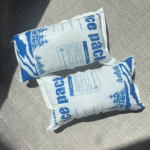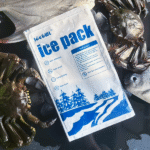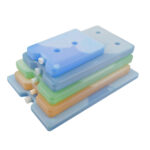Pengiriman barang yang sensitif terhadap suhu selalu menjadi tindakan penyeimbangan antara menjaga suhu yang tepat dan mengendalikan biaya. A paket es kering es fleksibel menawarkan solusi modern: paket gel yang dapat dibekukan kembali yang memberikan pendinginan di bawah nol tanpa bahaya es kering tradisional. Dalam panduan ini, Anda akan mempelajari cara kerja paket ini, mengapa mereka penting untuk logistik pangan dan farmasi, dan bagaimana teknologi baru mengubah lanskap rantai dingin. Apakah Anda mengirimkan makanan laut, vaksin atau paket makanan, memahami alat pendingin ini dapat membantu Anda pilih opsi terbaik.
Apa yang membuat paket es kering es fleksibel berbeda dengan es kering padat? – diskusikan kisaran suhu, dapat digunakan kembali dan aman.
Bagaimana Anda memilih solusi pendinginan yang tepat untuk pengiriman makanan dan farmasi? – gel penutup vs. es kering, durasi dan biaya pendinginan.
Apa praktik terbaik untuk menggunakan kembali dan menyimpan paket es kering es fleksibel? – tip keselamatan langkah demi langkah.
Bagaimana 2025 inovasi seperti sensor cerdas dan isolasi yang dapat didaur ulang mengubah kemasan rantai dingin? – mengeksplorasi tren keberlanjutan dan teknologi.
Apa yang Membuat Paket Es Kering Fleksibel Berbeda dengan Es Kering Padat?
Ketika orang mengatakan “bungkus es kering,” yang dimaksud mungkin berupa balok padat karbon dioksida beku atau kantong berbahan dasar gel yang berisi bahan pengubah fasa. Perbedaannya terletak pada komposisinya, suhu dan dapat digunakan kembali.
Memahami kedua produk tersebut
Paket CO₂ padat – Ini mengandung karbon dioksida murni yang dibekukan pada suhu –78.5 °C. Mereka memberikan pendinginan yang intens tetapi menyublim langsung menjadi gas saat memanas, tidak menyisakan apa pun untuk dibekukan kembali. Penanganannya memerlukan sarung tangan berinsulasi dan ventilasi untuk menghindari radang dingin dan penumpukan CO₂.
Paket fleksibel berbahan dasar gel – Kadang-kadang dipasarkan sebagai “paket es kering,” Kantong ini menggunakan gel super dingin atau bahan pengubah fasa yang dapat dibekukan berulang kali. Lembaran lanjutan dikembangkan pada tahun 2025 tahan suhu −12 °C hingga −18 °C hingga 48 jam dan dapat digunakan kembali 30 siklus dengan kurang dari 10 % kehilangan kapasitas. Tidak seperti es kering, mereka mencair tanpa kelembapan dan tetap fleksibel bahkan saat dibekukan, memungkinkan mereka untuk membungkus barang yang tidak beraturan.
Tabel perbandingan kinerja
| Fitur | Paket gel fleksibel | Es kering padat | Apa artinya bagimu |
| Suhu pendinginan | Tahan suhu −12 °C hingga −18 °C (kisaran perkiraan) | Menyediakan −78,5 °C | Pilih kemasan gel untuk makanan dingin (2–8 °C atau di bawah nol) dan es kering untuk barang-barang yang harus tetap beku. |
| Durasi pendinginan | Paket gel modern dapat mempertahankan suhu di bawah nol hingga 48 jam. Paket gel tradisional membeku tepat di bawah 0 °C dan memberikan pendinginan yang stabil untuk waktu yang lama. | Es kering menyublim sekitar 5–10 pon per hari dan secara bertahap kehilangan massanya; blok memberikan waktu penahanan yang lama tetapi pelet menghilang lebih cepat. | Paket gel menawarkan durasi yang dapat diprediksi; es kering mungkin bertahan lebih lama dalam balok besar tetapi memerlukan perhitungan yang cermat dan bobot ekstra untuk memungkinkan sublimasi. |
| Reusability | Paket gel dapat dibekukan kembali dan dapat digunakan kembali puluhan kali. | Es kering hanya dapat digunakan kembali jika masih ada sisa padat setelah pengiriman. | Paket gel yang dapat digunakan kembali mengurangi limbah dan biaya pengemasan hingga 75 % dan menghindari biaya bahan berbahaya. |
| Keamanan | Tidak beracun, mudah ditangani dan tidak berbahaya; dibuat dengan bahan food grade yang disegel dalam plastik. | Dapat menyebabkan radang dingin dan mati lemas jika salah penanganan; membutuhkan sarung tangan terisolasi dan ventilasi yang baik. | Paket gel lebih aman untuk pengiriman umum dan mengurangi dokumen peraturan. |
| Kelembaban dan kontaminasi | Tetap kering saat dicairkan; jangan membocorkan air atau mencemari barang. | Sublimasi langsung menjadi gas CO₂; Tidak ada residu cairan. | Kedua opsi tersebut menghindari kotak yang basah, tetapi paket gel menawarkan pembersihan yang lebih mudah. |
| Dampak Lingkungan | Paket gel yang dapat digunakan kembali mengurangi limbah; gel berbasis bio baru dan kemasan yang dapat didaur ulang semakin mengurangi jejak karbon. | Produksi es kering bergantung pada pasokan CO₂, yang dibatasi; permintaan tumbuh 5 % per tahun sementara pasokan hanya tumbuh sekitar 0.5 %. | Paket gel dapat mendukung tujuan keberlanjutan; kendala pasokan es kering dapat mendorong biaya. |
Mengapa perbedaan-perbedaan ini penting?
Memilih media pendingin yang tepat memastikan produk Anda tiba dengan aman dan sesuai standar. Paket gel memberikan pendinginan terkontrol untuk barang-barang berpendingin, sementara es kering memastikan pembekuan yang dalam untuk es krim atau sampel biologis. Obat-obatan yang terlalu dingin bisa sama berbahayanya dengan menghangatkannya; kemasan gel membantu mempertahankan kisaran suhu 2–8 °C yang diperlukan untuk vaksin dan diagnostik. Sementara itu, pengiriman steak beku atau reagen laboratorium sering kali memerlukan es kering; blok besar mengurangi sublimasi dan sesuai dengan waktu transit yang lama. Dengan memahami cara kerja setiap paket, Anda dapat menyeimbangkan persyaratan suhu, upaya penanganan dan biaya.
Cara Memilih Paket Es Kering Fleksibel untuk Kiriman Anda
Identifikasi sensitivitas suhu produk
Mulailah dengan mengklasifikasikan kargo Anda. Barang-barang farmasi dan bioteknologi sering kali memerlukan kisaran suhu 2–8 °C yang ketat atau suhu ruangan yang terkontrol. Makanan segar seperti susu, daging dan makanan laut harus berada tepat di bawah suhu pendingin untuk mencegah pembusukan. Barang beku seperti es krim atau vaksin harus tetap dibekukan, terkadang di bawah −20 °C, dimana es kering tradisional unggul. Paket gel yang fleksibel dapat mempertahankan suhu dingin atau di bawah nol derajat, sementara es kering membuat makanan tetap beku. Memilih cairan pendingin yang salah dapat membahayakan integritas produk.
Evaluasi durasi dan rute pengiriman
Waktu transit yang lama, penundaan bea cukai dan kondisi pengangkut yang tidak konsisten menimbulkan tantangan. Paket gel menawarkan waktu tunggu yang dapat diprediksi—hingga 48 jam untuk paket lanjutan. Untuk perjalanan lebih dari dua hari atau memerlukan cuaca dingin ekstrem, melengkapi paket gel dengan es kering atau mempertimbangkan pendinginan mekanis. Selalu kondisikan wadah terlebih dahulu dan minimalkan ruang kosong untuk memperlambat masuknya panas.
Pertimbangkan biaya, berat dan peraturan
Paket gel yang dapat digunakan kembali hemat biaya dalam beberapa siklus, menurunkan biaya pengemasan sebesar 75 % dibandingkan dengan pelet es kering sekali pakai dan menghilangkan biaya bahan berbahaya. Mereka juga menambahkan lebih sedikit bobot pada pengiriman dibandingkan es kering curah. Es kering lebih ringan dari air tetapi tetap menambah berat dan memerlukan kemasan tambahan untuk mengeluarkan gas. Pengiriman es kering memerlukan kepatuhan terhadap peraturan, termasuk pelabelan dan batasan kuantitas pada pesawat. Saat pengiriman melintasi perbatasan, pilih paket gel untuk menyederhanakan dokumentasi dan menghindari biaya tambahan yang berbahaya.
Praktik Terbaik untuk Menggunakan Kembali dan Menyimpan Paket Es Kering Fleksibel
Paket yang dapat digunakan kembali menghemat uang dan limbah, tetapi hanya jika ditangani dengan benar. Ikuti panduan ini:
Menggunakan kembali kantong es fleksibel berbahan dasar gel
Periksa dan bersihkan – Setelah membongkar kiriman Anda, periksa setiap paket gel apakah ada tusukan atau kebocoran. Jika utuh, bersihkan kondensasi dan biarkan hingga kering.
Flat beku – Letakkan bungkusan secara mendatar di bagian terdingin freezer Anda (–20 °C atau lebih dingin) selama 6–12 jam. Membekukannya hingga rata mencegah menggembung dan memastikan pendinginan yang seragam.
Putar inventaris – Simpan setidaknya dua set kemasan gel sehingga Anda selalu menyiapkan paket beku sementara paket lainnya mencair.
Lindungi penyimpanan – Simpan kemasan yang tidak terpakai di tempat yang bersih, tempat kering jauh dari benda tajam dan sinar matahari. Gunakan selongsong atau bungkus gelembung untuk penyimpanan jangka panjang.
Buang paket yang rusak – Ganti paket apa pun yang bocor, air mata atau gagal membeku sepenuhnya.
Menggunakan kembali es kering CO₂ padat
Kumpulkan sisa es kering – Buka kemasan di area yang berventilasi dan identifikasi bagian mana pun yang belum tersublimasi sepenuhnya.
Pindahkan dengan hati-hati – Gunakan penjepit untuk memindahkan sisa es kering ke dalam busa atau pendingin plastik tebal dengan penutup yang longgar. Hindari wadah kaca atau rapuh.
Pertahankan ventilasi – Jangan pernah menutup pendingin dengan rapat; gas harus keluar untuk mencegah penumpukan tekanan.
Simpan di ruang yang berventilasi – Simpan pendingin di garasi atau gudang luar ruangan, jauh dari ruang keluarga dan sumber panas.
Gunakan dengan cepat – Bahkan dalam wadah terisolasi, es kering menyublim dengan kecepatan 5–10 pon per hari; berencana untuk menggunakan kembali dalam dua atau tiga hari.
Contoh praktis: Sebuah perusahaan perlengkapan makan beralih dari pelet es kering sekali pakai ke kemasan gel fleksibel untuk pengiriman semalam. Dengan memutar dua set kemasan gel dan membekukannya pada suhu –20 °C, mereka mengurangi biaya pendinginan lebih dari itu 60 % dan menghilangkan dokumentasi bahan berbahaya. Kepuasan pelanggan meningkat berkat pembongkaran yang lebih mudah, dan perusahaan menyumbangkan sisa es kering ke laboratorium lokal saat digunakan.
Penerapan Paket Es Kering Es Fleksibel dalam Makanan, Farmasi dan Selanjutnya
Pengiriman makanan dan minuman
Barang yang mudah rusak seperti makanan laut, produk susu dan daging memerlukan pendinginan yang stabil untuk mencegah pertumbuhan bakteri dan menjaga rasa. Paket gel menjaga suhu aman dan banyak digunakan dalam pengiriman paket makanan, perdagangan elektronik kelontong dan layanan makanan. Karena disegel dalam kantong tidak beracun dan tidak bocor air, mereka menjaga kemasan tetap rapi dan menghindari kontaminasi silang. Untuk pengiriman makanan beku atau makanan penutup, melengkapi paket gel dengan balok es kering untuk menjaga kondisi beku dalam jarak jauh.
Farmasi dan bioteknologi
Pengendalian suhu sangat penting untuk vaksin, sampel biologis dan diagnostik. Kemasan gel menyediakan lingkungan terkendali pada suhu 2–8 °C tanpa risiko pendinginan super yang dapat ditimbulkan oleh es kering. Untuk terapi ultra dingin seperti perawatan sel dan gen, es kering dikombinasikan dengan teknologi penghalang dan pemantauan waktu nyata memastikan stabilitas. Sistem PCM yang dapat digunakan kembali semakin banyak digunakan untuk obat-obatan yang suhunya lebih rendah, mengurangi penggunaan es kering secara keseluruhan.
Industri, aplikasi kimia dan elektronik
Bahan kimia sensitif, komponen elektronik dan suku cadang industri seringkali memerlukan pengaturan suhu selama pengiriman atau pemrosesan. Peledakan es kering menggunakan pelet untuk pembersihan dan dekontaminasi, sementara paket gel digunakan untuk melindungi barang elektronik dari panas selama pengangkutan. Kontraktor yang menghadapi kekurangan es kering berinvestasi pada kapasitas pembuatan pelet lokal atau solusi hibrida yang menggabungkan es kering dan insulasi yang lebih baik.
Perawatan kesehatan dan terapi pribadi
Selain logistik, paket gel yang dapat digunakan kembali sangat populer untuk perawatan cedera, perawatan pasca operasi dan terapi olahraga. Pasar paket es global yang dapat digunakan kembali—bernilai USD 1.2 miliar pada tahun 2024—diperkirakan mencapai USD 2.14 miliar oleh 2032, tumbuh di a 7.5 % tarif tahunan gabungan. Paket berbahan dasar gel mendominasi karena fleksibilitasnya, daya tahan dan kapasitas pendinginan yang diperluas, cocok untuk penggunaan klinis dan rumah. Dalam terapi pribadi, mereka mengurangi ketergantungan pada obat-obatan, selaras dengan tren ramah lingkungan dan tersedia secara luas melalui pengecer online dan apotek.
2025 Inovasi: Tren yang Muncul dalam Kemasan Rantai Dingin
Pertumbuhan pasar dan tekanan keberlanjutan
Permintaan akan solusi rantai dingin terus meningkat. Pasar refrigeran kemasan rantai dingin global bernilai USD 1.57 miliar masuk 2024 dan diproyeksikan mencapai USD 1.69 miliar masuk 2025 dan Rp 2.92 miliar oleh 2032, memamerkan sebuah 8.14 % CAGR. Namun, pasokan es kering kesulitan untuk mengimbanginya; konsumsi meningkat di sekitar 5 % setiap tahun sementara pasokan CO₂ hanya meningkat sekitar 0.5 %. Dinamika ini mendorong minat terhadap alternatif seperti kemasan gel, bahan perubahan fasa dan pendinginan mekanis.
Inovasi material dan isolasi
Isolasi yang berkelanjutan dan dapat didaur ulang – Insinyur pengemasan sedang mengembangkan pelapis papan serat yang dapat didaur ulang, bahan nabati yang dapat terurai secara hayati dan tas jinjing yang dapat digunakan kembali untuk mengurangi limbah.
Panel terisolasi vakum (VIP) – Panel tipis dengan ketahanan termal tinggi mengurangi bobot dimensi dan mempertahankan waktu penahanan yang lama; biaya menurun seiring dengan skala produksi.
Gel dan PCM berbasis bio – Para peneliti sedang mengeksplorasi bahan perubahan fasa berbasis bio yang berasal dari minyak nabati yang menawarkan sifat termal yang lebih baik dan dampak lingkungan yang lebih rendah.
Pengemasan cerdas dan integrasi IoT
Pemantauan waktu nyata menjadi arus utama. Pencatat data dan sensor pintar yang ditempatkan di dalam paket melacak suhu, kelembaban dan lokasi selama transit. Integrasi IoT memungkinkan visibilitas lacak balak, memperingatkan pengirim untuk melakukan perjalanan dan mendukung analisis akar permasalahan. Perencanaan rute yang digerakkan oleh AI menyesuaikan jumlah paket gel berdasarkan prakiraan cuaca dan mengoptimalkan jalur pelayaran, mengurangi risiko dan jejak karbon.
Sistem yang dapat digunakan kembali dan dikembalikan
Perusahaan beralih ke pengiriman loop tertutup. Wadah berinsulasi kokoh dirancang untuk berbagai kegunaan, dengan pelacakan RFID atau kode batang untuk memudahkan pengembalian dan sanitasi. Pendekatan ini selaras dengan tujuan ekonomi sirkular dan mengurangi total biaya seiring berjalannya waktu. Paket gel yang dapat digunakan kembali secara alami cocok dengan sistem ini, menawarkan kinerja yang konsisten di seluruh siklus.
Tren peraturan dan keselamatan
Badan pengatur terus menerapkan pedoman ketat untuk pengiriman bahan berbahaya seperti es kering, termasuk batas kuantitas dan persyaratan pelabelan. Sebaliknya, kemasan gel—karena tidak berbahaya—menghadapi lebih sedikit batasan, menjadikannya menarik untuk perdagangan elektronik dan pengiriman lintas batas. Pelaporan keberlanjutan dan undang-undang tanggung jawab produsen yang diperluas mendorong merek untuk mengadopsi kemasan yang dapat didaur ulang atau terurai secara hayati dan mendokumentasikan dampak lingkungan dari rantai dingin mereka..
Penggerak pasar dan konsumen
Konsumen semakin mengharapkan makanan segar diantar ke depan pintu rumah mereka, memicu permintaan akan layanan perlengkapan makan dan pengiriman bahan makanan. Pada saat yang sama, perusahaan ilmu hayati mengandalkan kemasan dengan pengatur suhu untuk mengembangkan pasar biologi dan terapi gen. Banyak pengirim barang memandang keramahan lingkungan sebagai bagian dari identitas merek; kompres dingin yang dapat dibuat kompos dan kompartemen multi suhu bermunculan untuk memenuhi harapan ini. Tekanan-tekanan ini kemungkinan akan mempercepat adopsi paket es kering yang fleksibel dan teknologi pelengkap selama dekade berikutnya.
Pertanyaan yang sering diajukan (FAQ)
Q1: Apakah paket es kering es fleksibel aman untuk kontak dengan makanan?
Ya. Paket gel berkualitas tinggi menggunakan gel food grade yang disegel dalam plastik tidak beracun. Mereka menghindari kebocoran zat berbahaya dan menjaga bagian luar kemasan Anda tetap kering.
Q2: Berapa lama paket es kering es fleksibel tetap dingin?
Lembar kemasan gel tingkat lanjut dapat menahan suhu serendah −12 °C hingga −18 °C hingga 48 jam. Paket gel tradisional dibekukan tepat di bawah 0 °C memberikan pendinginan yang stabil untuk waktu yang lebih singkat.
Q3: Bisakah es kering digunakan kembali seperti kemasan gel?
Hanya jika masih ada CO₂ padat setelah pengapalan. Es kering menyublim langsung menjadi gas; setelah itu hilang, tidak ada yang perlu dibekukan kembali. Sebaliknya, kemasan gel dapat dibekukan kembali dan digunakan kembali puluhan kali.
Q4: Apa cara paling aman untuk menangani es kering?
Kenakan sarung tangan terisolasi dan pelindung mata, dan simpan es kering dalam wadah berventilasi. Jangan pernah menutupnya dengan rapat; pelepasan gas harus dibiarkan untuk mencegah penumpukan tekanan dan mati lemas.
Q5: Apakah paket gel kehilangan efektivitas seiring berjalannya waktu?
Paket gel berkualitas menjaga kinerja 30 atau lebih siklus dengan kurang dari 10 % kehilangan kapasitas. Buang paket apa pun yang bocor atau gagal membeku.
Ringkasan dan Rekomendasi
Paket es kering es fleksibel menjembatani kesenjangan antara es kering tradisional dan pendinginan gel. Mereka menawarkan pendinginan di bawah nol tanpa CO₂ yang berbahaya, tetap fleksibel saat dibekukan, dan bisa digunakan kembali beberapa kali. Saat memilih solusi pendinginan:
Sesuaikan cairan pendingin dengan persyaratan suhu produk Anda: gunakan kemasan gel untuk makanan dingin (2–8 ° C.) dan es kering untuk barang-barang yang memerlukan pembekuan dalam.
Menilai durasi transit dan mengkondisikan kontainer terlebih dahulu untuk memaksimalkan waktu tunggu.
Memprioritaskan keselamatan: paket gel tidak berbahaya dan mudah ditangani, sedangkan es kering membutuhkan alat pelindung dan ventilasi.
Merangkul keberlanjutan: paket yang dapat digunakan kembali mengurangi limbah dan biaya, sementara gel berbasis bio baru dan isolasi yang dapat didaur ulang sejalan dengan tujuan lingkungan.
Ikuti terus inovasi seperti sensor pintar, Panel VIP dan perencanaan rute AI untuk membuktikan cold chain Anda di masa depan.
Langkah selanjutnya yang dapat ditindaklanjuti
Audit portofolio produk Anda – Identifikasi item mana yang perlu didinginkan, suhu beku atau sangat dingin. Gunakan ini untuk membangun strategi pendingin.
Menerapkan sistem penggunaan kembali – Investasikan dalam dua set paket gel dan putar untuk memaksimalkan masa pakai. Lakukan pembersihan, prosedur pemeriksaan dan penyimpanan.
Optimalkan desain kemasan – Minimalkan ruang kosong, pilih insulasi yang dapat didaur ulang dan validasi waktu penahanan dalam kondisi nyata.
Integrasikan pemantauan – Mengadopsi pencatat data atau sensor IoT untuk melacak suhu dan lokasi selama transit.
Tetap mendapat informasi – Ikuti publikasi industri untuk pembaruan mengenai perubahan peraturan, inovasi material dan perkiraan pasar.
Tentang tempk
Tempk adalah spesialis dalam pengemasan rantai dingin. Kami merancang dan memproduksi paket es gel, alternatif es kering dan sistem pengiriman makanan yang terisolasi, aplikasi farmasi dan industri. R&Tim D terus meningkatkan kinerja dan keberlanjutan produk kami—seperti mengembangkan kemasan gel fleksibel yang tahan –12 °C hingga –18 °C hingga 48 jam—dan kami mendukung solusi kami dengan layanan pengujian dan validasi. Kami juga menawarkan bahan ramah lingkungan dan wadah yang dapat digunakan kembali untuk membantu Anda mencapai tujuan keberlanjutan Anda.
Tertarik untuk mengoptimalkan rantai dingin Anda? Hubungi kami untuk konsultasi dan temukan bagaimana paket es kering dan solusi pengemasan kami yang fleksibel dapat meningkatkan operasi pengiriman Anda.
























